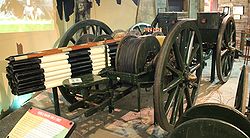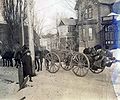Cable wagon
From RCSigs.ca
|
A cable wagon was a horse drawn wagon used for the laying of line for telegraphs and telephones.
A Wagon Telephone Mark I was a predecessor to the Cable wagon of the First World War. Introduced in 1911, the cable wagon continued to be used in the 1930's until it was phased out in favour of mechanical transport and mechanical line layers.
Crew
In 1915, the crew consisted of eight NCOs and men plus three drivers. The Commander was mounted and the drivers each controlled two horses of the six horse team.
- No. 1 (Base Operator) - complete office equipment from centre box of limber; joins up cable etc and tests through to No. 2.
- No. 2 (Wagon Operator) - sits on centre box of limber
- No. 3 - pays out cables - sits at rear of wagon
- No. 4 (Brakeman (hammer and jumper)) - sits on perch of wagon; executes pole crossings
- No. 5 - sits on off limber box; executes pole crossings
- No. 6 - mounted with crook - behind wagon; crookstick lays cable in ditch etc; ties back etc
- No. 7 - mounted well in rear of wagon; crookstick and makes off cable
In March 1917 the crew was modified to be 13 men in total. The Commander was mounted and the drivers each controlled two horses of the six horse team. The other nine consisted of three Office Telegraphists (No. 1, 2 and 9), three Sappers (No. 3, 4 and 5) and three Linesmen (No. 6, 7 and 8).
- No. 1 - 3rd Class office into Signal Office - Signal Office Operator
- No. 2 - Wagon Operator - sits on centre box of limber
- No. 3 - pays out cables - sits at rear of wagon
- No. 4 - Brakeman (hammer and jumper) - sits on perch of wagon; executes pole crossings
- No. 5 - sits on offside limber box; executes pole crossings
- No. 6 - mounted lineman with crookstick - lays cable in ditch etc in rear of wagon
- No. 7 - mounted - ties back well in rear
- No. 8 - Base lineman (mounted)
- No. 9 - Orderly man

























